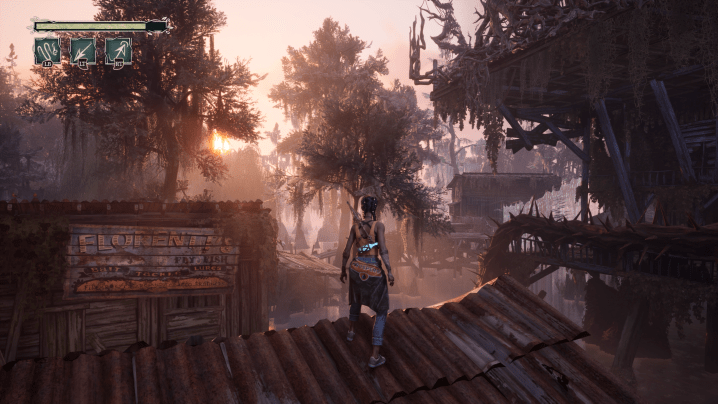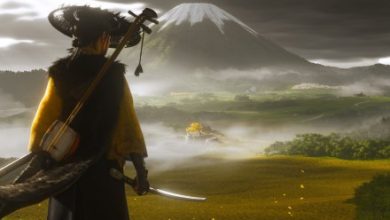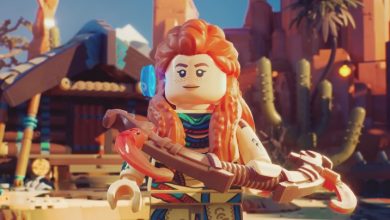South of Midnight knows exactly what it wants to be and is better for it

If all goes according to plan, Xbox has a big 2025 ahead of it. Obsidian will kick things off with Avowed next week, Doom: The Dark Ages is bound to be a hit, and Ninja Gaiden 4 will give a classic series the revival it deserves. All of that is happening in just the first few months of the year, with heavy hitters like Fable and Gear of War E-Day still to come. The most exciting game in Xbox’s lineup might be its smallest, though: South of Midnight.
The latest game from We Happy Few studio Compulsion Games left a big impression during last month’s Xbox Developer Direct. The action-adventure game takes players to the American deep south, which is brought to life with a striking art style inspired by stop-motion animation. That’s the kind of detail that’s bound to catch eyes, but it left me wondering what it would actually feel like.
Now that I’ve played a full chapter, I have a much clearer picture of South of Midnight beyond its aesthetic. Hardly anything feels out of place, as every system, set piece, and locale connects back to a clear and humble artistic vision. It’s a bit of a rarity for a modern game of its size: a tightly crafted adventure that’s laser focused on being exactly what it wants to be.
Reverse engineering
My demo takes me through South of Midnight’s third chapter. At that point in the story, a hurricane has already washed over the small town of Prospero. Playing as Hazel, I’m left to sort through the wreckage as I move through an eerily serene swamp baking in the Southern sun. What’s refreshing to learn right off the bat is that South of Midnight doesn’t burden players with an overwhelmingly large map. This is a classically linear adventure game, a decision that works entirely in its favor.
This doesn’t feel like a world composed of repeated assets to create the illusion of scale. Every corner of Prospero feels delicately handcrafted. When I walk into a dilapidated house, I’m taken aback by how much it feels like a real space. There’s a molding mattress nestled under a stairwell, family photos on the wall, even a quilt loosely draped over a banister. In these cramped spaces, I can feel their old owners trying to solve their storage needs with barely any space to work with.
“Prospero is a small town, and a lot of small towns in America — north, south, east, west — do have those kinds of problems,” Lanier tells Digital Trends. “They don’t have resources. People move away and don’t come back. But they’re still places that matter to people, and places that have a culture and history. The way we have Hazel interacting with those things, she’s emphatic. She’ll be mad that your house got foreclosed for you! But we also have glimpses of community. You’ll go into a house and see pictures of families or leftover quilts. Even though the world is kind of empty because of the hurricane, we populate it to make it feel lived in. This was someone’s home and it had to be left behind because of a natural disaster.”
That’s all brought to life thanks to South of Midnight’s distinct art style, which mimics physical stop-motion animation. I’ve appreciated what I’ve seen in trailers, but it’s even more impressive up close and in motion. Early in the chapter, I meet a giant catfish who’s in need of help. As I get close to the screen, I can see the attention paid to his construction. He’s a patchwork of textures, as if he was knitted into existence with fabrics salvaged around town. Though everything here is a 3D model, characters look like they were crafted by hand.

That look came from research. The team was inspired by fellow Canadians Clyde Henry Productions, an animation studio that Compulsion tapped to create a handmade intro cinematic for the game. Compulsion studied Clyde Henry’s work closely, reverse engineering the physical models used in its own films to convincingly mirror them in 3D. Art Director Whitney Clayton explains that the process inspired its artists to break out of their usual habits and take notes from a different medium’s nuances.
“There’s a lot of questions that came up that we didn’t realize would be questions,” Clayton tells Digital Trends. “If this existed in real life, what would the scale be? Because the scale next to a human will determine the size of a knit on somebody, or the amount of detail one could put into something by hand. It brought up a lot of questions of what checkboxes do the artist need to always consider when they’re making a prop. And by the time we got to the third or fourth prop, they started to internalize it.”
Weaving into battle
It doesn’t take long for me to grasp the straightforward gameplay loop. I walk through the bayou, occasionally poking around for collectible Floofs hidden behind little platforming segments squirreled away in optional paths. I have a double jump, air dash, and glide to help me get around, and I learn to wall run on billboards and hanging quilts midway through the chapter. All of my movements feel fluid, despite South of Midnight boldly opting to replicate a filmic “animating on twos” look (everything is still running at 60 frames per second under that, and picky players can disable the frame trick).
As I explore, I also get a feel for Hazel’s weaving powers, which play into both exploration and combat. For the former, I can use magical threads to construct platforms, break down debris in my path, and yank fallen scraps of metal off the ground to find hidden Floofs.
Those powers mostly come into play during battles against dark creatures, called Haints. These happen in set arenas placed on my path. When I walk into one, the environment closes in around me and I have to wipe out a few creatures to purify my way forward. Like everything else in South of Midnight, the combat system isn’t a mechanically heavy hodgepodge of ideas. Every single tool needs to be used in battle, from basic attacks to Hazel’s primary weave power. Failing to use those is a recipe for disaster. I almost got wiped out in my very first fight because I didn’t heed the developers’ early warnings to utilize my dodge roll.

Haints hit like a truck and Hazel doesn’t have a healing flash to drink out of. Instead, each arena only has one healing aura that can be picked up if she needs it. Otherwise, the only way Hazel heals is when she takes down an enemy’s health and then unravels them, granting her a bit of health. It’s South of Midnight’s wholesome version of Doom’s finishers. Once I understood the flow, it was easy to find the rhythm of battles. It’s a game of careful healing resource management, as I always wanted to know when I could push the advantage on an already weakened enemy if I took a hit and needed a quick heal. That makes for some surprisingly tense fights where it feels like I’m fighting down to the wire.
Aside from slashing, Hazel has a few weaving powers at her disposal. One yanks an enemy towards me while another repels them, two tools that are crucial in letting me manage enemy spacing when I get crowded. Another power lets me temporarily web an enemy up in thread, perfect for shutting down an incoming attack and quickly pushing the momentum to burn down a health bar in a pinch. The spell-casting system calls Hogwarts Legacy to mind, but it pulls more depth out of much fewer options.
If there’s any worry I have about the full game, it’s that these fights seem like they could get old fast. I was tossed into a handful of battles throughout the chapter and each felt more or less the same. I only faced off against a few enemy types, from a bug-spewing hive to hulking Haint whose projectiles I could send back with the right timing. I get the sense that Compulsion is being conservative with how much it peppers battles in so as not to stretch its concise system too thin, though I’m hoping there’s a little more to basic enemy variety in later chapters.
Hazel does have more tools that I’ve yet to see, though. There’s a whole skill tree that augments each weaving power and gives Hazel a few extra tricks. During my demo, I’d unlock the ability to perform a ground slam attack. Later in the game, she also gets a raggedy doll companion named Crouton who can mind control an enemy and sic it against another. Hopefully there’s enough in the tree to evolve later fights.
Deconstructing Southern gothic
Any combat nitpicks don’t feel like they’ll be terribly significant in the grand scheme of South of Midnight. More than anything, its appeal is in its narrative so far. It’s a story forged from film and literary influences, telling a magical realist tale in the vein of Big Fish (in fact, that’s the name of Chapter 3). Compulsion drew from a wide range of Southern gothic art history to build a world that fit into that storytelling tradition.
“I read Alice Walker, Toni Moirrson. I reread Their Eyes Were Watching God by Zora Neale Hurston. I watched Eve’s Bayou, which is a fantastic movie,” Lanier says. “And this isn’t Southern gothic, but I rewatched Spike Lee’s Crooklyn. It’s one of my favorite movies. The mother daughter relationship is a loose framework and I really like how it’s handled. We pulled from a lot of different things. I felt more pulled to some of the Black ones to create that air of authenticity. What does Black Southern gothic look like, specifically for Hazel?”
A mood that’s a bit contemplative, macabre, and symbolic.
That research comes out in the writing. While there’s an overarching narrative, Chapter 3 houses its own narrative arc that almost reads like a short myth. The chapter has me freeing my catfish pal from the Benjy Tree. I don’t know what that means at first, but I unravel that mystery as the chapter progresses. It builds to a dark revelation about a deadly spat between brothers, turning one into a living tree that I eventually need to climb in a climactic platforming segment. That segment is soundtracked by a full-on musical number, as the other brother sings what happened from his perspective. It’s a dark fairytale, but one born out of a grounded pain that runs through Prospero’s roots.
For Clayton, the goal wasn’t to copy scenes from books and movies. Rather, it was to dig into the genre and figure out how it’s built. It’s not so dissimilar to the way the art team took apart Clyde Henry’s models to reverse engineer them into video game assets.
“There’s a deconstructing of what the visual tropes of Southern gothic are,” Clayton says. “There’s this feeling of being trapped in time because these stories are usually in some way timeless. They’re usually set in a small, quiet place and everything is condensed in that place. There’s an overarching narrative, but then you have these very intimate stories that follow along with that. You kind of feel like the world stands still a bit. There’s the decaying architecture, the hanging moss on the live oaks. It all makes for a mood that’s a bit contemplative, macabre, and symbolic.”
All of this careful work shows in the final product, at least in the snippet I played. From evocative sound and visuals to a sub story that feels like it was ripped from local legend, South of Midnight looks to be accomplishing exactly what Compulsion set out to do. No more, no less. That’s refreshing in an age of bloated games that try too hard to be everything for everyone. This feels more sustainable by comparison: a focused vision that’s appropriately scoped around an audience that approaches games as artworks with perspectives, rather than seeing them as something to consume and spit out. I know which group I fall into.
South of Midnight launches on April 9 for Xbox Series X/S and PC.



